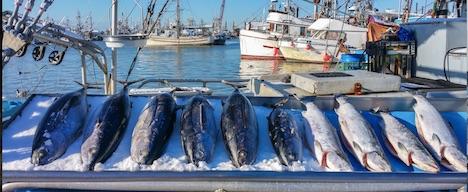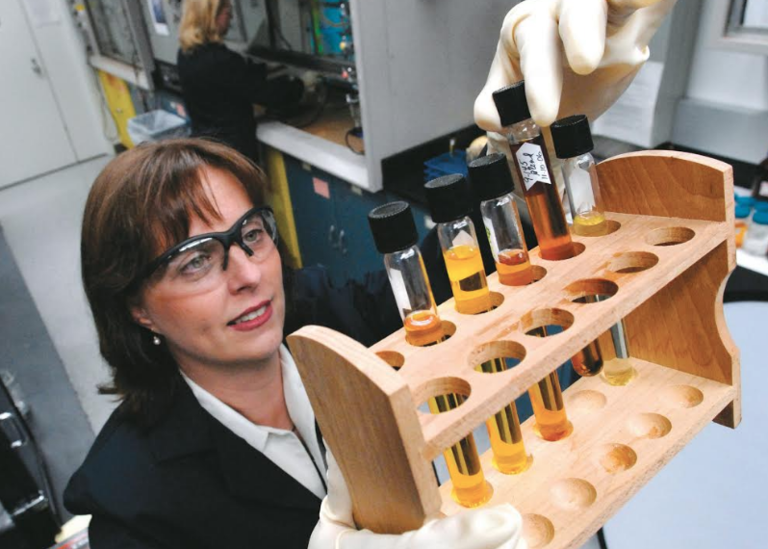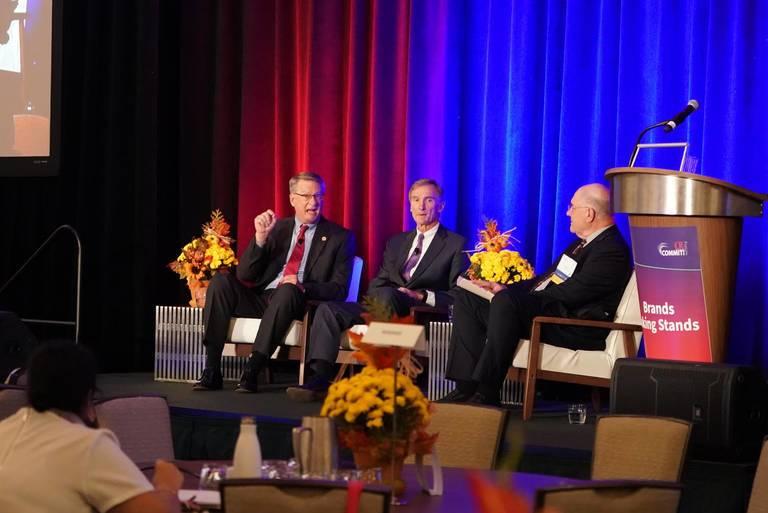How Smithfield Foods Frames Sustainability


By Debra Belluomini
Measuring past and potential financial returns is how businesses characterize ROI, but Smithfield Foods is moving beyond that definition with their sustainable take on the acronym: Responsibility, Operational excellence, and Innovation.
This set of core values is the CSR driver for the $14 billion global pork processor and hog producer, according to Stewart Leeth, Smithfield vice president of Regulatory Affairs and chief sustainability officer. Leeth provided an inside look at the company’s recent sustainability achievements and ambitious goals for the future at this year’s COMMIT!Forum.
“If you’re in the food business and know the food business, it is a very disruptive time in food manufacturing, probably the most disruptive time in most our memories,” Leeth said. “There are a lot of great opportunities and food challenges ahead.”
Those challenges cover a lot of ground: accelerating world population growth, extremes in weather, unprecedented access to information (most of which are negative reports, noted Leeth), and widely divergent views on how food should be manufactured. While disruption brings with it uncertainty and greater business risk, Smithfield is forging forward with numerous sustainability initiatives intended to build upon the organization’s values, mission, and goal to enhance its position as the world’s largest consumer packaged goods and protein company.
“Smithfield Foods is very focused on this (ROI) and our sustainability platform,” Leeth said. “It is starting to drive and accelerate the sustainability program in our company: taking responsibility for what you do, not walking by it - you own it; optimizing and making best uses of resources that we have and, of course, innovation. We have a brand new chief innovation officer who is focused on new products.”
Collectively comprising what Leeth calls “pillars” of value creation, Smithfield’s sustainability platform covers five key areas: animal care, environment, food safety and quality, people, and helping communities.
Animal care
How do those pillars translate to action in a global consumer packaged goods company? Leeth cited several examples, including the transition over the past 10 years toward “cage-free” enclosures that house pregnant sows on all company-owned farms (around 40 percent of suppliers).
“This is actually a seminal year for us,” said Leeth. “We report on this every year, and last year we were 87 percent, and this year we’re confident that we’re going to make that happen.”
Environment
Smithfield’s first sustainability initiative in the company’s 81-year history was tackling tough environmental issues in the food industry. It was the first food company in the industry to become ISO certified. In 2016, it put plans into place to attain its next industry ‘first’: a 25 percent absolute GHG reduction goal across Smithfield’s entire supply chain within the next 8 years.
Leeth explained, “We committed to reduce greenhouse gases across our entire value chain by 25 percent by the year 2025. The question is: How are you going to do that? That’s a big, bold commitment.”
The answer is a new business unit titled Smithfield Renewables, which will focus on reuse and renewable energy projects across the company’s operations in North American and Europe. Introduced publicly for the first time at COMMIT!Forum, the unit will be lead by Kraig Westerbeek, VP of Environment and Support Operations, and, according to Leeth, will yield results that equate to removing 900 thousand cars from roadways.
Smithfield is working with the Environmental Defense Fund to optimize fertilizer use on the company’s feed grain farms, upgrading equipment, and launching energy efficient projects such as transforming animal waste into renewable energy to ultimately produce more than 2 billion cubic feet of renewable natural gas – enough, says Leeth, to provide electricity to approximately 53 thousand homes for a year.
Another facet of this effort is value creation. Explained Leeth, “We had real challenges in our environment back in the 90s – the battle days I call it – and we’ve gradually grown this program to meet the needs of our stakeholders. Underlying that is something we call value creation, which is our take on shared values through which we try to articulate the projects that we are undertaking. We are creating value, not just for the company in terms of dollars and cents - which is important, but to many stakeholders and our customers. We’re a business-to-business company, so we want to make sure our brand is not a threat to other brands.”
Food safety and quality
In the food business, brands can be destroyed with just a single instance of a food-borne crisis – think the Mexican restaurant chain Chi Chi’s Hepatitis A outbreak in 2003 or Jack in the Box E. coil outbreak in 1993. Leeth stated that Smithfield has increased its long-standing vigilance to maintain high standards of food safety and quality through its Raise Your Hand program and it’s first sustainability web presence that contains a glossary for food ingredients. Site visitors can go to the glossary, look up terms found on food labels, and learn their meaning.
The Raise Your Hand program encourages all employees to engage in maintaining food safety and quality – and to speak out when they spot a problem.
“Smithfield Foods has been involved in food safety for a long time,” Leeth said. “Years ago we were featured on some magazines and a few months ago in a magazine that said that we had a food safety culture long before was deemed cool, and that’s very true. This program is designed to take responsibility for everybody in the plant.”
Describing the depth of the commitment, he explained how Smithfield integrates employees on an individual level. “Your job is food safety,” he said, referencing all of the company’s 50,000 employees. “Your job is if you see a problem, say something about it. Halt the line. And that’s a big deal to manufacturing company. If you halt the line, you’re going to cost the company money and cost that plant manager money, but we train our food safety folks and everyone that works in the field and on the floor to do that.”
People and helping communities
Most of Smithfield’s operations are in small communities across North American and Europe, which means they are often the largest employer in those communities. Therefore, said Leeth, the company’s focus is on local education, hunger relief programs such as Helping Hungry Homes and hiring veterans in those areas.
In 2016, Smithfield donated more than 17 million servings of food to those in need and the Smithfield Foundation awarded almost $400 thousand in college scholarships to dependent children and grandchildren of full-time and retired employees.
From core values to practical application, how does a global industry leader walk their CSR talk? Smithfield Foods seems to have the right approach, with their new chief innovation officer, Marketing SVP William Brunt, leading the charge for organization-wide engagement toward transformational change. The last decade has been a landmark timeframe for the company, as the recipient of at least 10 major sustainability awards. According to Leeth at COMMIT!Forum, the next 10 years promise to be equally impressive.
Seafood industry takes big steps toward sustainability


1400 Companies Now Put an Internal Price on Carbon


According to CDP, the global non-profit climate research provider, almost 1,400 multinational companies now factor an internal carbon price into their business plans. That number is an impressive leap, as it amounts to an eight-fold increase from 2014. Three years ago, only 150 such companies reported that they considered the price of carbon into their overall financial strategic planning. Compared to last year, this is an increase of over 10 percent.
The roster of companies includes 100 of the Fortune Global 500 companies, as well as utility companies including PG&E, Exelon, E.ON, France’s EDF and the U.K.’s National Grid. Furthermore, this is hardly a trend relegated to either side of the pond: companies in Asia are also adopting carbon pricing, including at least 102 in China.
CDP’s researchers have identified three overarching reasons why companies are launching carbon pricing procedures.
First, internalizing the price of carbon helps companies manage risks as it can help them gauge their vulnerability to regulations that could leave an impact if they do not reduce their carbon emissions. Companies that have disclosed this reason to CDP as motivation to adopt carbon pricing include Air Canada, LG Electronics, PG&E, Tata Steel and Volkswagen.
In addition, an internal price on carbon can actually help companies unveil opportunities in the wider marketplace. As policies evolve and more countries accelerate their transitions to more of a low-carbon economy, new business ventures could emerge. Therefore, an internal carbon price can be a factor in a company’s research and development strategy, or develop new products and services that are more relevant in a low-carbon economy. CDP cited Hitachi Chemical Company, Owens Corning and Royal DSM as examples on this front.
Finally, carbon pricing can serve as an effective transition tool to nudge a company to become more efficient and reduce emissions. An internal fee or “tax” can drive companies to invest in renewables, find ways to become more energy efficient, develop new goods and services or participate in voluntary carbon markets. Microsoft, which launched an internal carbon fee a few years ago, offers one such case study. Other companies that disclosed similar reasons to CDP include Natura, LafargeHolcim and Unilever.
Here in the U.S., the research indicates that more companies are forging ahead with such plans despite the uncertainty that keeps bubbling out of Washington, D.C. The number of U.S.-based firms incorporating carbon pricing has more than tripled since 2014, and CDP claims another 142 companies will launch such plans by 2019.
Depending on their home base, more companies may want to adopt carbon pricing as a hedge against climate change-related regulations. As of this year, over 40 national and 25 regional governments have imposed a price on carbon. As a result, at least 800 companies that have not adopted any sort of carbon pricing plan could be vulnerable over the next few years.
Image credit: Michael Mees/Flickr
Time to Get Your Hands Dirty at Work


By Emily Folk
Initially launched as a sustainable effort to offset our planet’s expected food shortage, urban agriculture now stands ready to revolutionize community-based health and wellness trends.
Successful corporate enterprise has begun to incorporate current gardening trends with innovative urban farming techniques to the mutual benefit of employee well-being and bottom-line production. Edging out traditional team-building events and happiness-quotient consultants, company gardens are the new eco-friendly work-endorsed health advantage.
Studies confirm that employees who interact directly with live plants report lower stress levels and exhibit higher mental acuity. Can company gardens really protect employee health, assure efficient organizational function and help the feed the world all at the same time?
Urban ingenuity
Urban agricultural projects utilize unique systems for maintaining necessarily scaled-down versions of sustainable food growth and marketability. Settings where soil is unavailable employ hydroponic techniques. This methodology allows plants to grow efficiently in nutrient-rich water, basically eliminating the need for dirt plots and note-worthy square footage.
Vertical farming is an alternative urban agricultural trend which employs traditional soil and fertilizing technique offers a unique spin on space requirements. Vertical farming is defined as food grown within a building, one story or higher. Assuring necessary light and water requirements, vertical farm yields mirror those of traditional fresh-air crops — and they do so strictly in urban settings.
Greenhouses are also an ideal option for growing greenery all year round. Although employees may not be able to work amongst the plants this way, it will still allow employees to rejuvenate around greenery and participate in growing food. Plants exposed to over 14 hours of light also produce more yield in fewer days, and energy efficient lights, like LED lights, can reduce energy consumption and costs.
Companies that bloom
At Kohl’s Wisconsin-based corporate headquarters, a 4,000 square foot garden is incorporated seamlessly into their shared office space. Kohl’s agricultural plot is solely employee-farmed and regularly provides fresh fruit and vegetables for use in their on-site cafeteria.
Blue Cross and Blue Shield of Minnesota displays a more community-minded stance. Their “Community Giving Garden” donates produce exclusively to local food banks and shelters. In true beaurocratic form, this company has published instructions and tips in order to help others start similar projects.
Timberland’s corporate headquarters in Stratham, N.H., launched a “Victory Garden” in 2008 with just 1,000 square feet. Farmed entirely by employee volunteers, harvested flowers and produce are available for purchase to Timberland staff members. Money raised is donated out. As of 2016 a total of $15,000 has been contributed to local food banks, and the garden occupies double its original space.
Chesapeake Energy, a natural gas company, also maintains company garden sites by employee volunteers. Currently, over two acres of raised beds are planted in their Oklahoma City headquarter compound. In 2010, an unanticipated hail storm destroyed their initial crops late in the growing season. The company, collectively, chose to rally and plant a second time. Their inspiring exhibit of resilience and persistence paid off, Chesapeake was able to donate over 300 pounds of sweet potatoes and okra to the local food pantry just in time for the Holidays.
Given seeds, space and opportunity; today’s visionary business leaders unquestionably reap what they and their employees sow — and then some. Local charitable organizations, as well as our planet’s food supply, have never been in such strong, callused hands.
Emily Folk is a freelance writer in the sustainability field and covers green technology, sustainability and conservation on her blog, Conservation Folks. You can also see her latest updates via Twitter.
REI Harnesses Yerdle to Take ‘Garage Sales’ Online


If you are a regular REI shopper, you have undoubtedly heard of, and most likely queued at, the outdoor gear and apparel retailer’s garage sales. Held at most stores once a quarter, they offer great discounts on goods that have been returned. The “pre-loved” goods are often indistinguishable to the naked at eye at a first glance; the previous customer may have just not wanted those hiking pants or LED lantern. REI’s “100 percent satisfaction guarantee” is one reason why these sales events are a regular occurrence, and they at the very least give the company an opportunity to recoup some of its losses while offering customers yet another reason to keep coming back.
And considering the deep price cuts, REI’s shoppers hardly seem to care about wear and blemishes -- the lines for these garage sales start snaking around and outside REI stores in the hours leading to the their kick offs. If you are venturing back into camping or cycling, these garage sales are a great place to start adding to your gear.
But those garage sales are only at the brick-and-mortar stores, so customers who don’t live close to the company’s 150-plus stores have been out of luck.
As of last week, that is going to change, due to REI’s partnership with Yerdle, the used goods exchange technology platform.
Yerdle launched earlier this decade, making a splash as it sought a role front-and-center within the emerging sharing economy. The idea was that (generally used) goods would be exchanged between users, who in turn would receive credits for additional goods. Users could buy credits if their accounts were too low in the event they coveted a certain item.
It was a great idea in concept, and Yerdle entered partnerships with companies aligned with this “reuse and recycle” sentiment; Patagonia and Levi’s were a couple examples. But the concept never really caught on. After all, we still have Craigslist, eBay and even the cardboard signs marked “free” we often see in front of homes and apartments.
But Yerdle’s technology is still around, and it works extremely well. In the meantime, the company has rebranded as Yerdle Recommerce, and is now focused on working with brands so that they can buy and sell used items.
Yerdle Recommerce is a perfect fit for REI. One challenge for the company is that a garage sale’s offerings are limited to what was returned at a specific store. The result is that REI stores were often stuck with items that will never move. In the meantime, a customer in a more remote area may have a near impossible time scoring that product, either because it is difficult to find or may not just be affordable. Suddenly, those size 14 boots or that mauve eight-person tent may finally find a home.
Consumers win because they finally have that clothing item or gear they’ve wanted but just could not land; REI benefits from that freed up space and claws back some of that otherwise lost revenue – and earns even more loyalty in the process, especially from shoppers who live nowhere close to one of its locations.
REI’s Used Gear site has been in beta testing and was soft-launched earlier this month; it officially opened last Friday.
Image credit: REI/Facebook
Why Video Is No Longer Optional


By Debra Belluomini
What’s your organization’s sustainability story-telling strategy? Vern Oakley, CEO of Tribe Pictures and speaker at this year’s COMMIT!Forum, asserts that video is the most compelling and high-visibility way to communicate your organization’s core values and achievements.
Considering that the Cisco Visual Networking Index projects that video traffic will grow three-fold between 2016 and 2021 to comprise 82 percent of all Internet traffic, organizations must embrace a video strategy to connect with today’s audiences, Oakley stated in a session titled, “The Camera Doesn’t Lie: Authentic Leadership Seeking Authentic Communications.”
Oakley, who has authored the book, Leadership in Focus: Bringing Out Your Best on Camera, made it clear that video is no longer optional for organizations. It’s a requirement now for leadership communications, marketing, recruiting, onboarding, employee communications, and much more.
“Almost every aspect of corporations have a way that videos are used, and I believe that CSR - as the conscience of the organization - needs to be woven into all of these things,” he said. “It can’t stand isolated and siloed. These thoughts have to be put out in all the work that your company is doing.”
Sharing video examples produced for Apple, energy company Hess, the accounting firm KPMG, and Avon’s breast cancer awareness campaign, Oakley based his position not only on IP traffic forecasts but also on research conducted about the human dimension of CSR and the emotional connection that video can generate.
“A well-crafted video is the quickest way of making an emotional connection,” Oakley explained. “A lot of science has come out in the last few years. Information leads to understanding, but emotion leads to action. If you want to change things in your company and change things in the world, we need action, not just understanding.”
Careful, though: It’s not just about generating emotion in a video; the emotion needs to feel authentic, and today’s binge-watching audiences are undoubtedly more sophisticated when it comes to spotting contrived storylines and emotional manipulation when they see it.
“Audiences know the difference between good and bad storytelling. They know authenticity, and they know when they’re being sold something,” he cautioned.
What’s at stake for CSR professionals who recognize the value of video? Two issues, according to Oakley: First, people who know how to use videos strategically will have the power to create change. Second: If you don’t tell your story, someone else will and probably in a way that you don’t want them to.
While there is no question that video is a compelling medium for sustainable storytelling, as the saying goes, execution is everything. If done right, said Oakley, “There’s magic in those pixels.”
Over Half a Trillion Soybeans Later, Ford Marks 10-Year Anniversary of Bio-based Foam


It has been 10 years since Ford Motor Company rolled out the 2008 Mustang with seats comprised of soy-based foam. Since then, the automaker says it has installed this bio-based form in at least 18.5 million cars that have rolled off the company’s assembly lines.
According to Ford, the use of soy-derived foam instead of such material made out of petroleum has prevented 288 million pounds of carbon from entering the atmosphere. The 578 billion soybeans churned into foam, claims the company, are equivalent to 4 million trees removing carbon from the earth’s atmosphere over the course of a year.
Ford says the soybean-based foam is the standard material used in its cars’ seat cushions, backs and headrests. The automaker first seriously considered scaling up the use of soy foam when oil prices soared during 2008. The company’s executive chairman, Bill Ford, worked with organizations including the United Soybean Board in ensuring that the soy foam could become a viable alternative to the conventional materials then on the market.
This decade, Ford’s researchers have tinkered with a variety of bio-based products to use within its automobiles and trucks. Coconut fibers to reinforce resins, shredded denim for insulation, kenaf for door bolsters and battery trays and even shredded U.S. currency for plastic parts have all been material experiments at Ford. The company currently says other materials, such as captured CO2, tomato peels, agave fiber, dandelions, bamboo and algae, are now on its radar. In addition, upholstery made out plastic bottles has appeared in more F-150 trucks. Ford has also partnered with Coca-Cola, Heinz, Nike and Procter & Gamble to boost the development of bio-based plastics.
Some observers may sniff at Ford’s research on bio-based products, and wonder aloud what the point of all this may be if the company is still manufacturing automobiles with internal combustion engines. But the automaker has also had an eye on the future, with investments in self-driving cars and mobility technologies. The company has no choice: the concept of automobile ownership is changing, and electric vehicles keep performing in range, performance and design.
Finally, Ford’s research and development with bio-based products is about more than scoring a few public relations points. The scale that companies like Ford and its competitors offer means that these new innovations have a chance at reaching even further than these companies’ supply chains. If more bioplastics can supplant those made out of petroleum and other fossil fuels, then the environment can also score a win in the long run.
Image credit: Ford
Candriam's ESG study rates 74 countries globally as 'investable'


Opioid Crisis: CEOs Must Stand Up and Unite


By Debra Belluomini
The opioid crisis isn’t only a health issue anymore. It’s becoming a hot button in corporate social responsibility circles and a catalyst for public and private sectors to unite to fight the epidemic, as Leidos CEO Roger Krone attested to at a COMMIT!Forum panel session on Tuesday.
Leidos, a Fortune 500 science-technology company and multibillion-dollar defense contractor based in Reston, Va., has partnered with the state of Maryland to bring awareness to the issue and create programs and volunteer efforts aimed at prevention, enforcement, and treatment.
Krone -- gathered on the COMMIT!Forum stage with Clay Stamp, executive director of Maryland’s Opioid Operational Command Center, and moderator John Howell, editorial director of 3BL Media -- is urging other CEOs to join the fight against opioid abuse.
Krone first became aware of the severity of the crisis when he received an email from John Hindman, a Pittsburgh-based Leidos employee who had lost his son to an opioid overdose. In his email, Hindman challenged Krone to take action.
After looking at the numbers, Krone was shocked by the swath of opioid-related deaths in 2016 alone, exceeding the combined fatalities of U.S. soldiers in Vietnam, Desert Storm, Desert Shield, and Enduring Freedom. Collaborating with the State of Maryland state government and the Chris Atwood Foundation, a Northern Virginia non-profit organization dedicated to assisting opioid addicts, Krone moved forward to launch several initiatives that started a chain of discussion that exposed the breadth and depth of the issue that in some way had touched almost everyone at Leidos.
“The reaction with our employees has been overwhelming,” Krone told the COMMIT!Forum audience. “Every one of our 32,000 employees had been touched in some way within their household or through a friend or a child of a friend that has been involved in the crisis.”
Stamp, the former Ocean City emergency management chief for nearly three decades, provided insight into Gov. Larry Hogan’s decision to declare a state of emergency in Maryland to battle the epidemic and why private-public partnerships dedicated to this issue are so important.
“In Maryland the numbers are stark,” Stamp explained. “What is challenging is that there’s so much stigma associated with this crisis. When I say stigma, I mean personal embarrassment. People are afraid to speak about it. It’s isolation. It’s depression. It is pervasive. It’s on trial right now because there are so many competing views about how to handle it. In Maryland, we are taking a balanced approach: prevention, enforcement, expansion of access to treatment.”
The numbers associated with the crisis underscore the need for urgent action. Of the 2,000 people in Maryland who died from opioid overdose last year, 80 percent of those individuals previously had been treated in hospital emergency rooms for non-fatal overdoses. Stamp explained that Gov. Hogan’s decision to declare a state of emergency was a clear call to action. Today, 14 state agencies are working to deliver coordinated efforts and 80 state projects are in the launch phrase or are already underway. Among those is a model for the law enforcement community to help substances abusers enter treatment instead of incarceration.
Stamp asserted that the long-term solution to the crisis is education at primary and secondary schools. “Prevention, which is the long game, is to begin to remove demand, and that’s getting into schools. It used to be cool to smoke. It’s not cool to smoke anymore. We had an issue with the AIDS epidemic. Behavior changed and because behavior changed, the numbers dropped. So, we can do that as a nation. This is a crisis that requires all of us to get in the game.”
The combined efforts of Leidos and the State of Maryland demonstrate that private-public partnerships can create powerful change if CEOs step up to engage. To learn more about their stand to address the opioid epidemic, visit the Leidos call to action web page and http://beforeitstoolate.maryland.gov.
Uber Shows Saudi Women Winning Right to Drive Is About Money, Influence and Perhaps, Human Rights


The world has been buzzing the past two weeks after Saudi Arabia’s government announced that after years of arrests, protests and international outcry, women have gained the right to drive.
While many hailed the decision as a victory for the #Women2Drive movement as well as human rights in the Middle East, much of the change in policy is due to pragmatic reasons. After all, women are increasingly becoming a larger part of the country’s workforce; not being allowed to drive forces families to budget for private drivers, an expensive proposition as many of them are immigrants from abroad. For a country that has long sought to curb its reliance on foreign labor, the long road to “Saudization” needs to start at home.
Some observers of Saudi politics and culture suggested changes at home began when the country’s Public Investment Fund (PIF) invested $3.5 billion in the ridesharing company Uber last year. Dan Primack of Fortune slammed the transaction at the time. “To my knowledge, no other Silicon Valley startup has a director from the sovereign wealth fund of a repressive political regime,” Primack wrote in a fit of pique.
At the time, many commentators joined Primack in his fury, as many were appalled that Uber would take such a huge wad of cash from a country that for decades had stubbornly banned women from driving.
But it turns out that investments in companies such as Uber, no matter how bad the optics may have looked on either side, were necessary for this country of 32.3 million people to diversify its economy if citizens were to have ample work opportunities in the long term. Most estimates suggest the country’s vast oil reserves account for 90 percent of the country’s export value, and funds almost that same ratio of the nation’s budget. If the world ever hits "peak oil," or as the current conventional wisdom suggests, oil becomes irrelevant, many of Saudi Arabia's citizens will be left with few employment options unless the country's economy becomes less depended on fossil fuels.
Furthermore, Saudi Arabia’s consumption of oil is hugely inefficient. The country has long used its oil stocks for power generation; a few years ago, a study suggested that if the country did not manage its reserves wisely, the country would could risk having to import oil by 2030 to meet its surging population’s demands. Investments in solar and wind power could help the country meet its electricity requirements while allowing it to still milk its cash cow of oil reserves.
But Saudi Arabia would still need to find ways to keep its people employed, and therein lies opportunities for companies such as Uber. In fact, the company has reportedly already started training women to work for it as drivers.
As Alison Griswold of Quartz explains:
“Uber can’t be credited for getting Saudi Arabia to change its stance on women driving. But in meetings with Saudi officials, the company used its position as PIF’s single biggest investment to push for women being allowed to drive, a person familiar with Uber’s operations in the Middle East told Quartz. The company framed the issue as a path toward economic empowerment in a country that has made it a stated goal to put more Saudi nationals—women included—to work.”
Uber, of course, would not be the only transportation company benefiting from allowing women to drive. Careem, a similar ridesharing service that operates in Saudi Arabia and other Gulf states such as the United Arab Emirates, would also gain a steady pool of new drivers. Meanwhile, despite the new decree and the rush of women scrambling to score a driver’s license, both ridesharing companies should still see a steady stream of customers.
Most estimates suggest 80 percent of ridesharing customers in Saudi Arabia are women. Even though the new law states that women do not need permission from their fathers or husbands to drive, social norms may get in their way of their newly found four-wheel freedom; but at the same time, many of those women not quite ready to drive will at least be able to hail a ride from one of their peers.
Image credit: Carlos Latuff/Wiki Commons